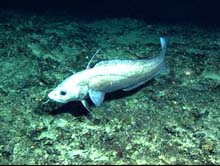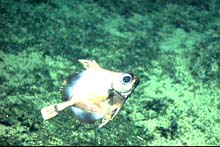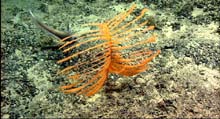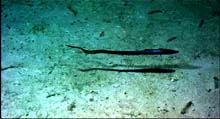How Many Species of Fish Live on Seamounts?
August 24, 2005
Peter Auster
University of Connecticut
One of the questions that ecologists ask is how many species live in a particular habitat. The answer to this question, at first blush, would seem simple. Visit a particular habitat, count as many animals as possible until there are no new species to add to your list, and you have your answer. Unfortunately, this is easier said than done. For example, how many individuals do you count before you know you have an adequate sample, especially if you occasionally add a rare species to your list?
Seamounts are particularly challenging places to assess patterns of diversity and community structure. These environments have steep and complex topography that are not amenable to collecting specimens by towing a net - the standard tool used by fish ecologists. We use visual census techniques much like those used by scuba divers on coral reefs to determine the relative abundance, species-habitat associations, and patterns of diversity of seamount fish communities. However, instead of strapping a scuba tank on our backs and jumping directly into the water, we use the ROV Hercules to dive to over 1000 m depths to collect information about fishes.
For our dive today, like all dives previous to this, we had multiple objectives. For example, each dive is used to census fishes, corals, and other invertebrates using video transects across multiple habitats. We collect various species of live corals for taxonomic, genetic, and reproductive studies. Finally, we collect fossil corals for studies of climate change. Obviously, many tasks need to be accommodated on each dive, making the search for fishes a bit of a challenge. In order to get the most out of the time underwater, we use encounter rates with fishes as a method to determine community structure and patterns of diversity.
The process works essentially like this: Hercules flies over the bottom between areas that we stop and sample. During these periods we encounter fishes of various species. We use the video to zoom in on the fishes and get images used for species identification. Using these fish counts and images, we can quantify the general pattern of how species observed on seamounts increases as the number of individual fishes encountered increases. Fish communities in different habitats have characteristic trends. For example, tropical coral reefs have high numbers and high diversity of fishes but have few individuals representing each of the many species. In the Gulf of Maine, there are fewer overall species and few species are dominant while many others are rare in number. Understanding such patterns adds a piece to the puzzle of how fish communities are structured, helps define questions for future research, and aids in conservation planning. We are in the midst of collecting data on such patterns for seamount fishes. Whatever the answer, it will lead us to ask new questions and increase our ability to understand and conserve these unique communities in the deep sea.
Sign up for the Ocean Explorer E-mail Update List.




























